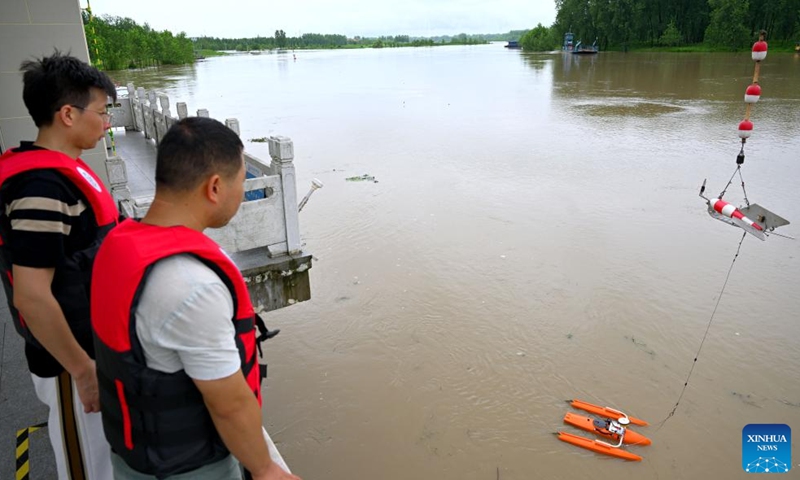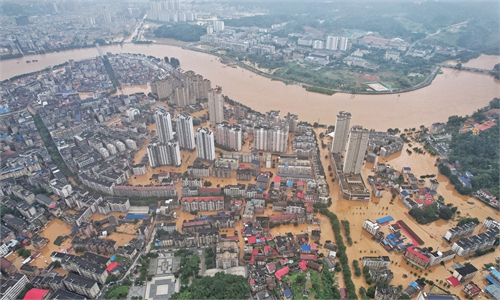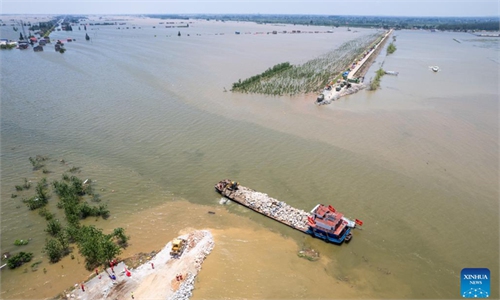
Staff members monitor the flood water at a hydrological station in Funan County of Fuyang, east China's Anhui Province, July 14, 2024. Measures including monitoring the flood water, inspecting embankment and ensuring flood-control materials have been taken by the authorities of Funan County of Fuyang, east China's Anhui Province, to control the "No. 1 Flood" for Huaihe River. Photo: Xinhua
As China is about to enter the critical flood control period between late July and early August at a time when river flooding caused by prolonged rain is expected to ravage parts of the country more intensely and more frequently, China's Ministry of Water Resources is preparing to implement working mechanisms to cope with the grim and complex situation.
A total of 31 flood-swollen rivers in multiple places across the country, including Southwest China's Chongqing Municipality, Central China's Hubei Province and Northeast China's Jilin Province, exceeded warning levels between Saturday morning and Sunday morning. As of Sunday afternoon, the Ministry of Water Resources had maintained a Level-III flood control emergency response in East China's Anhui and Jiangxi provinces and Central China's Hunan Province while maintaining a Level-IV emergency response in five provinces including Northeast China's Heilongjiang Province and Southwest China's Chongqing Municipality and Sichuan Province.
The ministry and China Meteorological Administration jointly issued a red alert, the highest level, for mountain floods on Sunday evening, warning of a high probability for mountain floods in the cities of Bazhong and Guangyuan in Sichuan between Sunday evening and Monday evening.
According to the ministry, drought and flooding occurred simultaneously and earlier this year, with greater volume, longer duration and faster development.
Major rivers and lakes in the Pearl River, Yangtze River, Taihu Lake, and Huaihe River basins have experienced 20 major floods since the start of this year's flood season. At present, the second flood in Taihu Lake and the first flood in the Huaihe River are still expanding, while the first and second floods in the Yangtze River basin are still ongoing. Meanwhile, emergency responses to the subsequent risks at the Tuanzhou embankment in Huarong county, Central China's Hunan Province, are still underway.
During the critical flood control period between July 16 and August 15, China will experience concurrent droughts and floods, with flooding expected to be more severe than droughts. Extreme events such as heavy rain and floods have become more frequent, widespread, and intense this year, leading to severe impacts and constituting a grim and complex situation.
Local water resources departments will fully initiate work mechanisms for the flood control critical period, further strengthening preventive measures, including forecasting, early warning, drills and planning. It will also ensure comprehensive defensive measures are implemented to handle extreme situations such as downpours, flooding, risks and disasters, the ministry said.
Unified and coordinated management of water conservancy projects across the river basins will be emphasized, with efforts focused on ensuring the safety of reservoirs during floods, managing floods in small- and medium-sized rivers, and preventing mountain flooding, according to the ministry.
According to the flood forecast for the flood control critical period, floods may occur in the seven major river basins, with multitask flood control work being conducted. Besides this, during this year's critical period there will be more rainfall in the northern area and less in the southern area. At present, the flood control capacity of small- and medium-sized reservoirs is low and many dams are unsafe and problematic, leading to high safety risks, the ministry said.
On Sunday, China's State Flood Control and Drought Relief Headquarters and China's Ministry of Emergency Management organized a joint consultation meeting with various departments and dispatched work teams in 15 provinces via video, during which they urged departments in localities to strengthen dike patrols and floodwater drainage, properly resettle affected residents, and speed up recovery and reconstruction of affected areas.
Since July 8, the main rain area in the Yangtze River basin has moved from the middle and lower reaches to the upper reaches of the Yangtze River, with multiple places including Southwest China's Sichuan Province and Chongqing Municipality and the Three Gorges Reservoir area suffering from prolonged downpours and tributaries such as the Minjiang River and Jialing River have been experiencing multiple rounds of rising water.
The Three Gorges Dam opened its sluice gates for the first time this year on July 10 to discharge floodwater, with the outflow flow increased from 27,000 cubic meters to 31,000 cubic meters per second, with the aim of controlling the water level in the reservoir before the flood crest arrives.
Due to the impact of the downpours and floods, Neijiang city in Sichuan had relocated over 8,000 residents as of Sunday morning and increased the emergency response for flood control in the city to Level-III from Level-IV.
In Chongqing, monitoring by the city's hydrological monitoring station showed that between Saturday morning and Sunday morning, heavy rains swept through 28 districts in the municipality and water levels in six rivers exceeded warning levels.
Due to the impact of local heavy rainfall and upstream inflows, the Tongnan section of the Qiongjiang River in Chongqing saw its first flood peak of 2024 on Sunday. A total of 12,857 residents from 5,251 households in the city's Tongnan district were relocated on Sunday.
A staff member from the city's emergency response bureau told the Global Times on Sunday evening that while rainfall in the urban areas of the city had stopped, the authority was still carrying out follow up work.
Apart from the Yangtze River basin, the Taihu Lake basin saw its second flood of the year while the Huaihe River basin experienced its first on Saturday.
The Ministry of Water Resources has maintained a Level-IV emergency response for flood control in East China's Jiangsu Province while the Taihu Basin Authority of Ministry of Water Resources has dynamically optimized and adjusted its drainage plan, directing provinces and cities within the basin to continuously increase drainage efforts.
The Ministry also maintained a Level-III emergency response for flood control in East China's Anhui Province and immediately dispatched a work group to the province to assist in flood control.
On Sunday, China's State Flood Control and Drought Relief Headquarters and China's Ministry of Emergency Management organized a joint consultation with various departments and dispatched work in 15 provinces via a video conference, urging departments in localities to strengthen dike patrolling and floodwater drainage, properly resettle affected residents, and speed up recovery and reconstruction of affected areas.



